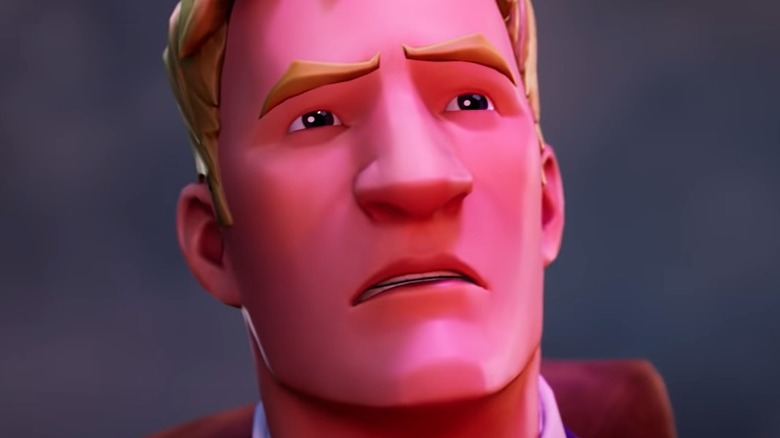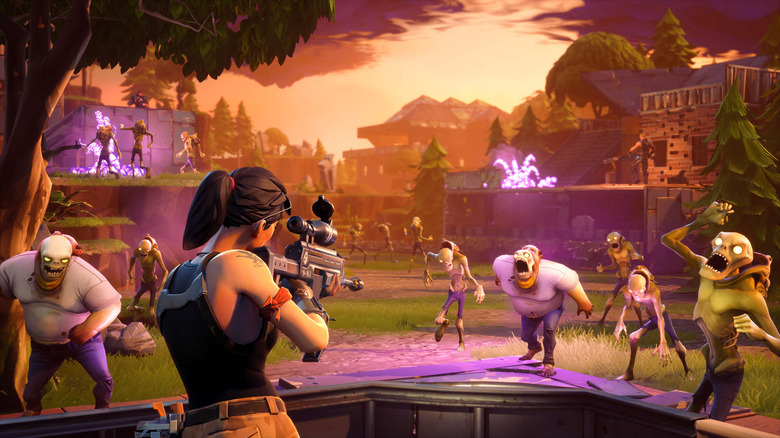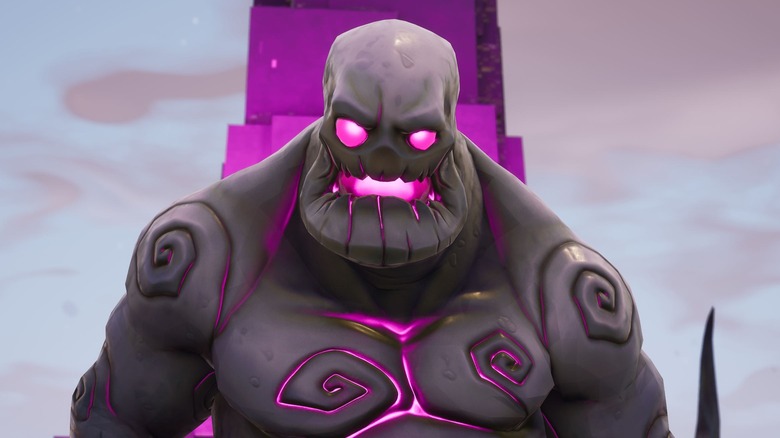Fortnite Was Originally A Much Darker Game
"Fortnite" released back in 2017 and, after a rocky start, turned into a massive hit and cultural phenomenon. The game continued to build on this success, gaining more fans and releasing content in the form of new seasons, upgrades, and skins. Part of its popularity may stem from Epic Games' ability to adapt, keeping "Fortnite" fresh and continuously giving players what they want. From paying homage to the latest viral dance craze to removing its most famous mechanics and even exploring a completely different perspective, Epic Games is known for regularly shaking things up.
What fans may not know is that big changes were taking place before the title even released. "Fornite" might have found a winning formula within the last few years, but it was almost a totally unrecognizable game when it was being made. Over the years, the folks who created the smash hit building-and-blasting title have opened up about its unusual development history, revealing that when "Fortnite" was still in development, it had a much different look, tone, and gameplay loop. Indeed, as originally conceived, "Fortnite" was a darker and more intense experience than what players eventually got.
Fortnite changed styles to speed up production
As art director Pete Ellis explained to Game Informer in a behind-the-scenes video, "Fortnite" began with more of a "dark survival tone." The "Fortnite" team has noted that the early designs for the game were much moodier and darker, with significantly less color in its landscape. In fact, Ellis compared the overall vibe of the game to something more akin to the horrifying "Resident Evil" series — a far cry from the neon-filled and sunlight-drenched world that "Fortnite" would become. Epic Games had just wrapped up production of "Gears of War 3" under the leadership of Cliff Bleszinski, a figure the industry doesn't hear much from anymore, so it makes sense that the game would initially lean more into this type of direction. But as luck would have it, the developers made the decision to change this approach based on a factor that had nothing to do with design preferences.
Some members of the team concluded that switching to a more goofy tone and cartoon aesthetics would dramatically speed up production. Developing and rendering animations would be much faster and require less impressive hardware if they weren't going for a realistic look. As the game's mechanics began to take shape — including, as Ellis put it, "ridiculous things like breaking down a wall with a stick" — the brighter and sillier art style just seemed to make the most sense.
According to "Fortnite" producer Roger Callum, "It took a while because we were, like, showing people our inner kid." While it took a bit of convincing, Epic Games eventually came around and embraced the new style.
Fortnite never forgot its roots
Of course, "Fortnite" never fully left horror behind, as certain events set in the world of the game have embraced the creepier elements from the title's origins. For instance, "Fortnite: Save the World" frequently put players up against creatures called Husk Monsters, while 2018's "Fortnitemare" event introduced an enemy mob called Cube Monsters. Though it may only be noticed by the adults playing "Fortnite," these creatures are definitely zombies, complete with shambling animations and a hunger for the living. Meanwhile, even some of the game's comic book-centric events, like the big battle with Marvel's Galactus from a few seasons back, have been noted as being pretty scary.
This glimpse into its development history also serves as a reminder that "Fortnite" was originally designed as a co-op survival game (via The Guardian). The battle royale mode that came to define the title was never part of the original plan. Between the new mode and the change in tone, "Fortnite" ended up looking completely different from how it was first conceived.
And of course, what seemed like a risky and confusing move to Epic at the time has paid off time and time again. The battle royale mode proved to be central to the success of "Fortnite" and the silly, cartoon look was a big hit with kids and helped the game differentiate itself from its chief competitor, "PUBG." It's hard to say if "Fortnite" would have been as successful if it had embraced a grittier survival vibe similar to games like "Rust" or "DayZ," but thankfully fans will never have to find out. "Fortnite" serves as a lesson to developers that they shouldn't be afraid to alter plans and that development can lead to unexpected results.



